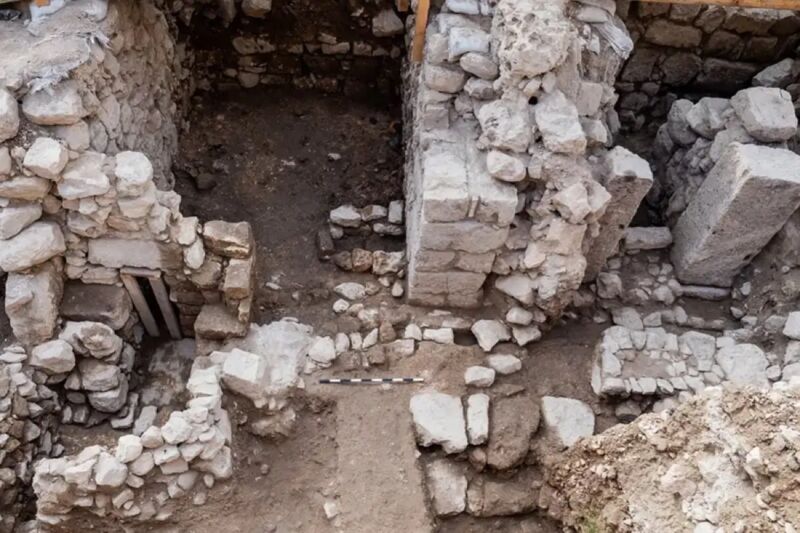Enlarge Assaf Peretz/Israel Antiquities Authority reader comments 2 There’s rarely time to write about every cool science-y story that comes our way. So this year, we’re once again running a special Twelve Days of Christmas series of posts, highlighting one science story that fell through the cracks in 2020, each day from December 25 through January 5. Today: Archaeologists relied on chemical clues and techniques like FTIR spectroscopy and archaeomagnetic analysis to reconstruct the burning of Jerusalem by Babylonian forces around 586 BCE.
Archaeologists have uncovered new evidence in support of Biblical accounts of the siege and burning of the city of Jerusalem by the Babylonians around 586 BCE, according to a September paper published in the Journal of Archaeological Science. The Hebrew bible contains the only account of this momentous event, which included the destruction of Solomon’s Temple . “The Babylonian chronicles from these years were not preserved,” co-author Nitsan Shalom of Tel Aviv University in Israel told New Scientist .
According to the biblical account, “There was a violent and complete destruction, the whole city was burned and it stayed completely empty, like the descriptions you see in [the Book of] Lamentations about the city deserted and in complete misery. ” Judah was a vassal kingdom of Babylon during the late 7th century BCE, under the rule of Nebuchadnezzar II. This did not sit well with Judah’s king, Jehoiakim, who revolted against the Babylonian king in 601 BCE despite being warned not to do so by the prophet Jeremiah.
He stopped paying the required tribute and sided with Egypt when Nebuchadnezzar tried (and failed) to in invade that country. Jehoiakim died and his son Jeconiah succeeded him when Nebuchadnezzar’s forces besieged Jerusalem in 597 BCE. The city was pillaged and Jeconiah surrendered and was deported to Babylon for his trouble, along with a substantial portion of Judah’s population.
(The Book of Kings puts the number at 10,000. ) His uncle Zedekiah became king of Judah. Zedekiah also chafed under Babylonian rule and revolted in turn, refusing to pay the required tribute and seeking alliance with the Egyptian pharaoh Hophra.
This resulted in a brutal 30-month siege by Nebuchadnezzar’s forces against Judah and its capital, Jerusalem. Eventually the Babylonians prevailed again, breaking through the city walls to conquer Jerusalem. Zedekiah was forced to watch his sons killed and was then blinded, bound, and taken to Babylon as a prisoner.
This time Nebuchadnezzar was less merciful and ordered his troops to completely destroy Jerusalem and pull down the wall around 586 BCE. Advertisement There is archaeological evidence to support the account of the city being destroyed by fire, along with nearby villages and towns on the western border. Three residential structures were excavated between 1978 and 1982 and found to contain burned wooden beams dating to around 586 BCE.
Archaeologists also found ash and burned wooden beams from the same time period when they excavated several structures at the Giv’ati Parking Lot archaeological site, close to the assumed location of Solomon’s Temple. Samples taken from a plaster floor showed exposure to high temperatures of at least 600 degrees Celsius Enlarge / Aerial view of the excavation site in Jerusalem, at the foot of the Temple Mount Assaf Peretz/Israel Antiquities Authority However, it wasn’t possible to determine from that evidence whether the fires were intentional or accidental, or where the fire started if it was indeed intentional. For this latest research, Shalom and her colleagues focused on the two-story Building 100 at the Giv’ati Parking Lot site.
They used Fourier transform infrared (FTIR) spectroscopy—which measures the absorption of infrared light to determine to what degree a sample had been heated—and archaeomagnetic analysis, which determines whether samples containing magnetic minerals were sufficiently heated to reorient those compounds to a new magnetic north. The analysis revealed varying degrees of exposure to high-temperature fire in three rooms (designated A, B, and C) on the bottom level of Building 100, with Room C showing the most obvious evidence. This might have been a sign that Room C was the ignition point, but there was no fire path; the burning of Room C appeared to be isolated.
Combined with an earlier 2020 study on segments of the second level of the building, the authors concluded that several fires were lit in the building and the fires burned strongest in the upper floors, except for that “intense local fire” in Room C on the first level. Advertisement “When a structure burns, heat rises and is concentrated below the ceiling,” the authors wrote. “The walls and roof are therefore heated to higher temperatures than the floor.
” The presence of charred beams on the floors suggest this was indeed the case: most of the heat rose to the ceiling, burning the beams until they collapsed to the floors, which otherwise were subjected to radiant heat. But the extent of the debris was likely not caused just by that collapse, suggesting that the Babylonians deliberately went back in and knocked down any remaining walls. Furthermore, “They targeted the more important, the more famous buildings in the city,” Shalom told New Scientist, rather than destroying everything indiscriminately.
“2600 years later, we’re still mourning the temple. ” While they found no evidence of additional fuels that might have served as accelerants, “we may assume the fire was intentionally ignited due to its widespread presence in all rooms and both stories of the building,” Shalom et al. concluded.
“The finds within the rooms indicate there was enough flammable material (vegetal and wooden items and construction material) to make additional fuel unnecessary. The widespread presence of charred remains suggests a deliberate destruction by fire. .
. . [T]he spread of the fire and the rapid collapse of the building indicate that the destroyers invested great efforts to completely demolish the building and take it out of use.
” DOI: Journal of Archaeological Science, 2023. 10. 1016/j.
jas. 2023. 105823 ( About DOIs ).
.
From: arstechnica
URL: https://arstechnica.com/?p=1993081



